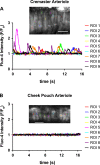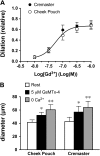Regional heterogeneity in the mechanisms of myogenic tone in hamster arterioles
- PMID: 28667050
- PMCID: PMC5625173
- DOI: 10.1152/ajpheart.00183.2017
Regional heterogeneity in the mechanisms of myogenic tone in hamster arterioles
Abstract
Myogenic tone is an important feature of arterioles and resistance arteries, but the mechanisms responsible for this hallmark characteristic remain unclear. We used pharmacological inhibitors to compare the roles played by phospholipase C (PLC; 10 μM U73122), inositol 1,4,5-trisphosphate receptors (IP3Rs; 100 μM 2-aminoethoxydiphenylborane), protein kinase C (10 μM bisindolylmaleimide I), angiotensin II type 1 receptors (1 μM losartan), Rho kinase (10 nM-30 μM Y27632 or 300 nM H1152), stretch-activated ion channels (10 nM-1 μM Gd3+ or 5 μM spider venom toxin GsMTx-4) and L-type voltage-gated Ca2+ channels (0.3-100 μM diltiazem) in myogenic tone of cannulated, pressurized (80 cmH2O), second-order hamster cremaster or cheek pouch arterioles. Effective inhibition of either PLC or IP3Rs dilated cremaster arterioles, inhibited Ca2+ waves, and reduced global Ca2+ levels. In contrast, cheek pouch arterioles did not display Ca2+ waves and inhibition of PLC or IP3Rs had no effect on myogenic tone or intracellular Ca2+ levels. Inhibition of Rho kinase dilated both cheek pouch and cremaster arterioles with equal efficacy and potency but also reduced intracellular Ca2+ signals in both arterioles. Similarly, inhibition of mechanosensitive ion channels with Gd2+ or GsMTx-4 produced comparable dilation in both arterioles. Inhibition of L-type Ca2+ channels with diltiazem was more effective in dilating cremaster (86 ± 5% dilation, n = 4) than cheek pouch arterioles (54 ± 4% dilation, n = 6, P < 0.05). Thus, there are substantial differences in the mechanisms underlying myogenic tone in hamster cremaster and cheek pouch arterioles. Regional heterogeneity in myogenic mechanisms could provide new targets for drug development to improve regional blood flow in a tissue-specific manner.NEW & NOTEWORTHY Regional heterogeneity in the mechanisms of pressure-induced myogenic tone implies that resistance vessels may be able to alter myogenic signaling pathways to adapt to their environment. A better understanding of the spectrum of myogenic mechanisms could provide new targets to treat diseases that affect resistance artery and arteriolar function.
Keywords: arterioles; hamster; microcirculation; myogenic tone.
Copyright © 2017 the American Physiological Society.
Figures










References
-
- Abramoff MD, Magelhaes PJ, Ram SJ. Image processing with ImageJ. Biophoton Int 11: 36–42, 2004.
Publication types
MeSH terms
Substances
Grants and funding
LinkOut - more resources
Full Text Sources
Other Literature Sources
Miscellaneous

